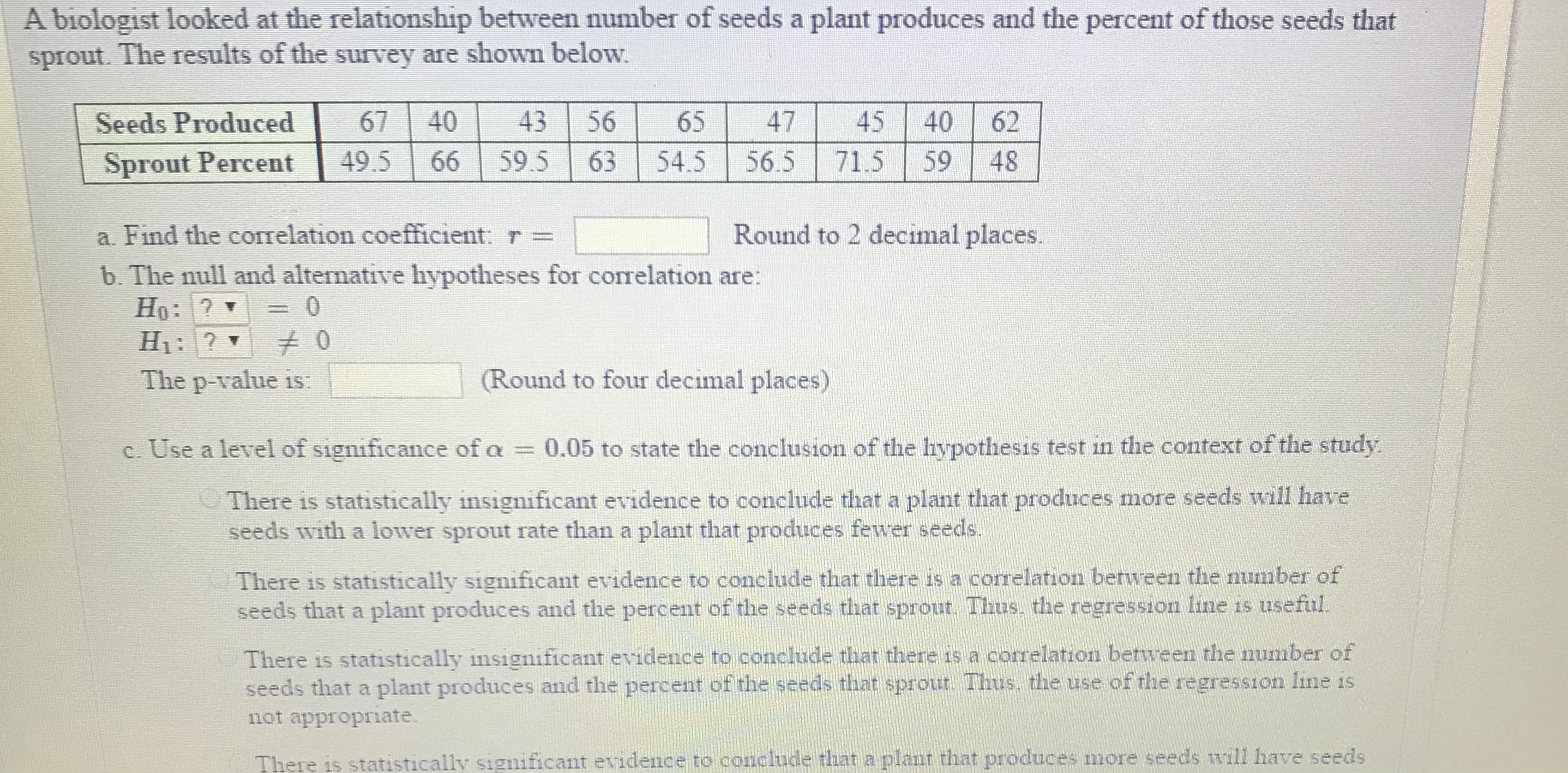A biologist looked at the relationship between number of seeds a plant produces and the percent of those seeds that sprout. The results of the survey are shown below. Seeds Produced Seeds Produced67 40 43 56 654745 40 62 67 | 40 | 431,56 ㄒㄧ-65 ㄒㄧ-47 45 T40162 Sprout Percent 49.5 66 595 63 54.5 565 715 59 48 a. Find the correlation coefficient: b. The null and alternative hypotheses for correlation are: Round to 2 decimal places. The p-value is: (Round to four decimal places) c. Use a level of significance of a 0.05 to state the conclusion of the hypothesis test in the context of the study There is statistically insignificant evidence to conclude that a plant that produces more seeds will have seeds with a lower sprout rate than a plant that produces fewer seeds There is statistically significant evidence to conclude that there is a correlation between the number of seeds that a plant produces and the percent of the seeds that sprout. Thus, the regression line is usefiul There is statistically insignificant evidence to conclude that there is a correlation between the number of seeds that a plant produces and the percent of the seeds that sprout. Thus, the use of the regression line is not appropriate There is statistically significant evidence to conclude that a plant that produces more seeds will have seeds
A biologist looked at the relationship between number of seeds a plant produces and the percent of those seeds that sprout. The results of the survey are shown below. Seeds Produced Seeds Produced67 40 43 56 654745 40 62 67 | 40 | 431,56 ㄒㄧ-65 ㄒㄧ-47 45 T40162 Sprout Percent 49.5 66 595 63 54.5 565 715 59 48 a. Find the correlation coefficient: b. The null and alternative hypotheses for correlation are: Round to 2 decimal places. The p-value is: (Round to four decimal places) c. Use a level of significance of a 0.05 to state the conclusion of the hypothesis test in the context of the study There is statistically insignificant evidence to conclude that a plant that produces more seeds will have seeds with a lower sprout rate than a plant that produces fewer seeds There is statistically significant evidence to conclude that there is a correlation between the number of seeds that a plant produces and the percent of the seeds that sprout. Thus, the regression line is usefiul There is statistically insignificant evidence to conclude that there is a correlation between the number of seeds that a plant produces and the percent of the seeds that sprout. Thus, the use of the regression line is not appropriate There is statistically significant evidence to conclude that a plant that produces more seeds will have seeds
Glencoe Algebra 1, Student Edition, 9780079039897, 0079039898, 2018
18th Edition
ISBN:9780079039897
Author:Carter
Publisher:Carter
Chapter4: Equations Of Linear Functions
Section4.5: Correlation And Causation
Problem 15PPS
Related questions
Question

Transcribed Image Text:A biologist looked at the relationship between number of seeds a plant produces and the percent of those seeds that
sprout. The results of the survey are shown below.
Seeds Produced
Seeds Produced67 40 43 56 654745 40 62
67 | 40 |
431,56 ㄒㄧ-65 ㄒㄧ-47
45 T40162
Sprout Percent 49.5 66 595 63 54.5 565 715 59 48
a. Find the correlation coefficient:
b. The null and alternative hypotheses for correlation are:
Round to 2 decimal places.
The p-value is:
(Round to four decimal places)
c. Use a level of significance of a 0.05 to state the conclusion of the hypothesis test in the context of the study
There is statistically insignificant evidence to conclude that a plant that produces more seeds will have
seeds with a lower sprout rate than a plant that produces fewer seeds
There is statistically significant evidence to conclude that there is a correlation between the number of
seeds that a plant produces and the percent of the seeds that sprout. Thus, the regression line is usefiul
There is statistically insignificant evidence to conclude that there is a correlation between the number of
seeds that a plant produces and the percent of the seeds that sprout. Thus, the use of the regression line is
not appropriate
There is statistically significant evidence to conclude that a plant that produces more seeds will have seeds
Expert Solution
This question has been solved!
Explore an expertly crafted, step-by-step solution for a thorough understanding of key concepts.
This is a popular solution!
Trending now
This is a popular solution!
Step by step
Solved in 7 steps with 5 images

Recommended textbooks for you

Glencoe Algebra 1, Student Edition, 9780079039897…
Algebra
ISBN:
9780079039897
Author:
Carter
Publisher:
McGraw Hill

Big Ideas Math A Bridge To Success Algebra 1: Stu…
Algebra
ISBN:
9781680331141
Author:
HOUGHTON MIFFLIN HARCOURT
Publisher:
Houghton Mifflin Harcourt

Holt Mcdougal Larson Pre-algebra: Student Edition…
Algebra
ISBN:
9780547587776
Author:
HOLT MCDOUGAL
Publisher:
HOLT MCDOUGAL

Glencoe Algebra 1, Student Edition, 9780079039897…
Algebra
ISBN:
9780079039897
Author:
Carter
Publisher:
McGraw Hill

Big Ideas Math A Bridge To Success Algebra 1: Stu…
Algebra
ISBN:
9781680331141
Author:
HOUGHTON MIFFLIN HARCOURT
Publisher:
Houghton Mifflin Harcourt

Holt Mcdougal Larson Pre-algebra: Student Edition…
Algebra
ISBN:
9780547587776
Author:
HOLT MCDOUGAL
Publisher:
HOLT MCDOUGAL